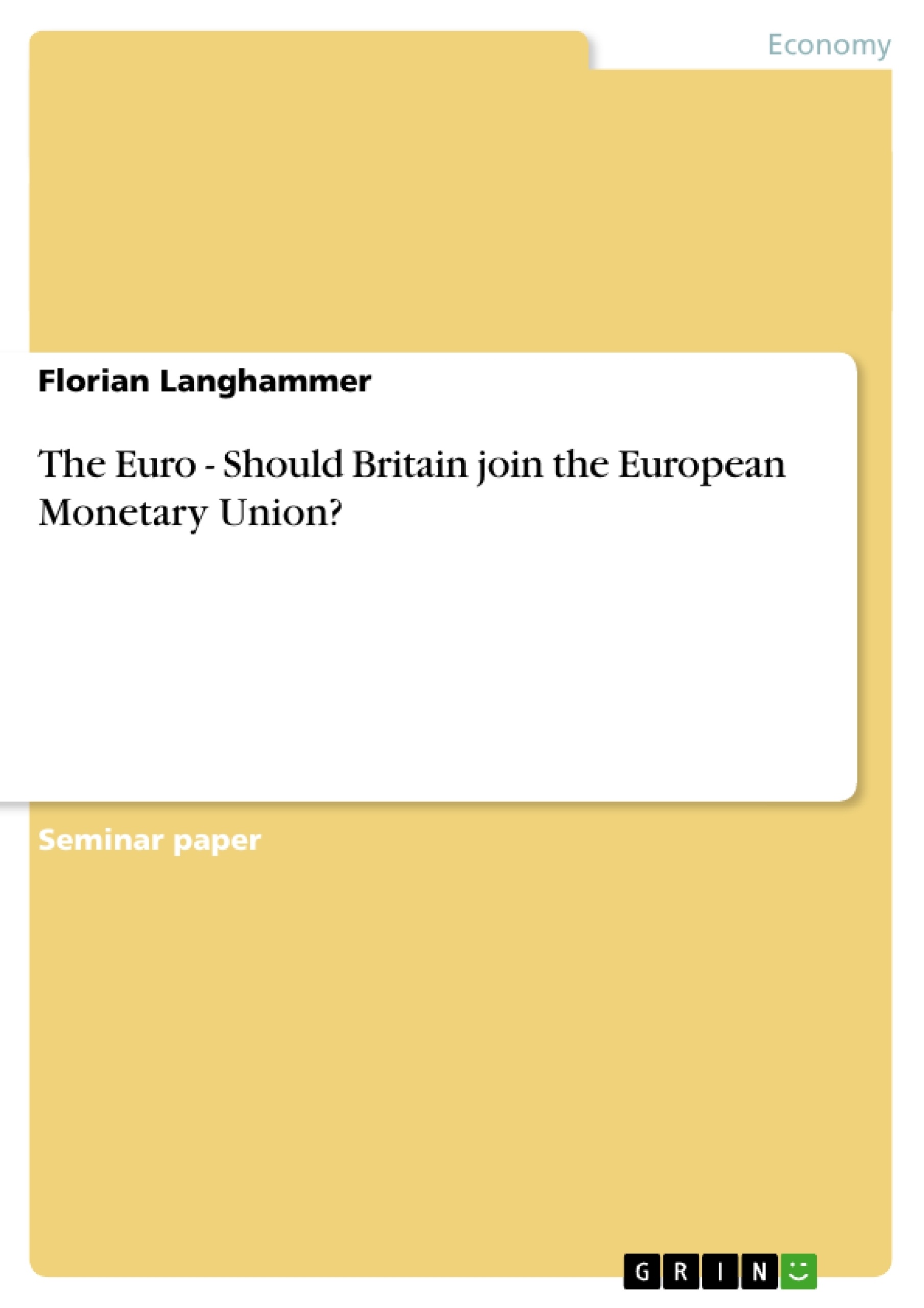HISTORICAL INTRODUCTION OF THE EMU
With the Maastricht Treaty the EC heads of state and government agreed on a three-legged "European Union" (EU) on December 9 and 10, 1991, which should include a common foreign and security policy, cooperation on domestic and security policy and the creation of a European Economic and Monetary Union (EEMU).
The European Monetary Union (EMU) is to be effected according to a concrete time schedule - the three-stage plan which was agreed upon in the Maastricht Treaty and the conversion plan which was decided December 1995.
To ensure the stability of a single currency, especially in the initial phase, the states participating in the EMU must satisfy the following convergence criteria as constituted in the Maastricht treaty:
1. Inflation criteria: Price stability with no more than 1.5 percentage points above the inflation rate of the top three member states.
[...]
Table of Contents
1. Historical introduction of the EMU
2. Discussion on Britain’s decision whether to join the EMU
2.1 Recent developments since 1. January 1999
2.2 Macroeconomic perspectives
2.2.1 Advantages
2.2.2 Disadvantages
3. Conclusion
4. Bibliography
5. Appendix
1. Historical introduction of the EMU
With the Maastricht Treaty the EC heads of state and government agreed on a three-legged "European Union" (EU) on December 9 and 10, 1991, which should include a common foreign and security policy, cooperation on domestic and security policy and the creation of a European Economic and Monetary Union (EEMU).
The European Monetary Union (EMU) is to be effected according to a concrete time schedule - the three-stage plan which was agreed upon in the Maastricht Treaty and the conversion plan which was decided December 1995.
To ensure the stability of a single currency, especially in the initial phase, the states participating in the EMU must satisfy the following convergence criteria as constituted in the Maastricht treaty:
1. Inflation criteria: Price stability with no more than 1.5 percentage points above the inflation rate of the top three member states.
2. Interest rate criterion: Long-term nominal interest rates not more than 2 percentage points above the corresponding rate in the three member states with the best results in price stability.
3. Exchange rate criterion: Maintain the normal bandwidths in the exchange rate mechanism of the European Monetary System (EMS) for the last two years without strong tensions.
4. Financial policy criteria: The ratio between public sector deficit and GDP must be not more than 3% per year. Total public sector debt may not make up more than 60% of the GDP at market prices.
The monetary union started on January 1, 1999, where the 11 member states adopted the Euro as an official currency, the European Central Bank (ECB) took over the monetary policy with a focus on price stability at a low inflation rate.
Source: WestLB “Euro Information”
2. Discussion on Britain’s decision whether to join the EMU
2.1 Recent developments since 1. January 1999
Since its launch in January 1999, the euro has revived a steady depreciation relative to the dollar, the pound, and the yen. Despite a recent recovery, it is not clear if this shift will constitute a reversal of the trend observed since October 2000. According to Soper, J C (2001) this development can be explained by a significantly faster growth rate in the US than in euroland, fuelled by an expansionary monetary policy of the European Central Bank (ECB).
After the parliamentary election in June 2001 where Labour revived another landslide success, pressure from British and multicultural business sectors has grown on Tony Blair to join the euro bloc. Most of these companies are major exporters to continental Europe and have been hit hard by the pound’s relative strength to the euro.
However, a final decision depends on the goodwill of Gordon Brown, Chancellor of the Exchequer. He has stated five economic tests in October 1997, that must be passed before Britain is ready for entry, (see appendix).
New potential members of the euro bloc have also emerged since the launch of the single currency. Greece has joined on January 1, 2001 and Eastern European nations such as Poland, Hungary, and the Czech Republic seek to join EU and the euro club in the next round.
According to Jack Straw, member of the Labour party, Britain will make an “economic assessment of euro membership within two years”. “Opinion polls suggest people are three to one against membership of the single currency”, writes the Financial Times (June 17, 2001).
2.2 Macroeconomic perspectives
The move to a single currency has many potential benefits, however, these don’t come without costs. Underneath a number of perspectives, that deserve particular consideration, are discussed.
2.2.1 Advantages
Lower costs of exchange:
“Perhaps the strongest economic argument […] for implementing the single currency is the reduction (or elimination) of currency-conversion transaction costs”, (Soper, J C, 1999): As transaction costs fall, trade is fuelled. Of course banks or firms can also reap the same benefits by carrying out their transactions in euro rather than in sterling. However, according to Wren-Lewis, S (2000) permanent savings in transaction costs just account for 0.3 to 0.6 percent of GDP.
The basic argument of euro advocates is that manufacturer cost savings would finally result in a fall of consumer prices. Sober, J C (1999) however points out that, an increase of trade within the euro zone may have trade-destroying on countries outside the currency area, as they are excluded.
[...]
- Arbeit zitieren
- Florian Langhammer (Autor:in), 2001, The Euro - Should Britain join the European Monetary Union?, München, GRIN Verlag, https://www.grin.com/document/24171
-

-

-

-
Laden Sie Ihre eigenen Arbeiten hoch! Geld verdienen und iPhone X gewinnen. -

-
Laden Sie Ihre eigenen Arbeiten hoch! Geld verdienen und iPhone X gewinnen. -

-
Laden Sie Ihre eigenen Arbeiten hoch! Geld verdienen und iPhone X gewinnen. -

-
Laden Sie Ihre eigenen Arbeiten hoch! Geld verdienen und iPhone X gewinnen. -

-
Laden Sie Ihre eigenen Arbeiten hoch! Geld verdienen und iPhone X gewinnen.

